Papers by Robinah Kulabako

Hydrogeology Journal
Weathered basement aquifers are vital sources of drinking water in Africa. In order to better und... more Weathered basement aquifers are vital sources of drinking water in Africa. In order to better understand their role in the urban water balance, in a weathered basement aquifer in Kampala, Uganda, this study installed a transect of monitoring piezometers, carried out spring flow and high-frequency groundwater level monitoring, slug tests and hydrochemical analyses, including stable isotopes and groundwater residence time indicators. Findings showed a typical weathered basement aquifer with a 20–50-m thickness. Groundwater recharge was 3–50 mm/year, occurring during sustained rainfall. Recharge to a deep groundwater system within the saprock was slow and prolonged, while recharge to the springs on the valley slopes was quick and episodic, responding rapidly to precipitation. Springs discharged shallow groundwater, mixed with wastewater infiltrating from onsite sanitation practices and contributions from the deeper aquifer and were characterised by low flow rates (< 0.001 m3/s), low...
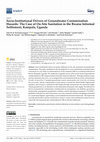
Water, 2021
Socio-institutional factors are poorly addressed in the risk assessment of groundwater contaminat... more Socio-institutional factors are poorly addressed in the risk assessment of groundwater contamination. This paper contributes to the development of a socio-institutional assessment framework based on a case study of contamination by on-site sanitation (OSS) in an informal settlement of Bwaise (Kampala, Uganda). We conducted a snapshot survey of the recent extent of groundwater contamination by OSS using microbial and hydro-chemical indicators. Through transition arenas and key informant interviews, we investigated the socio-institutional drivers of the contamination. Overall, 14 out of the 17 sampled groundwater sources tested positive for Escherichia coli during the wet season. Nitrate concentrations at four sources exceeded the World Health Organization guideline value (50 mg/L), attributed to OSS. Despite the high contamination, the community highly valued groundwater as an alternative to the intermittent municipal water supply. We deduced six drivers of groundwater contamination,...

Journal of Contaminant Hydrology, 2006
An investigation to assess the anthropogenic pollutant loads, transport and impact on shallow gro... more An investigation to assess the anthropogenic pollutant loads, transport and impact on shallow groundwater in one of Kampala’s peri-urban areas (Bwaise III Parish) was undertaken. Bwaise III is a densely populated informal settlement with a high water table ( 0.25mm/min) result in rapid flooding occurring within 1hr to 2 days. With lower rains, the water table does not rise to the surface, and no flooding takes place. Protection of the shallow groundwater in the area requires socio-technical measures targeting reduction of pollutant loads within the area as well as a wider spring catchment. Re-protection of the spring, coupled with awareness creation, should be immediately addressed so as to reduce microbial contamination. Community participation in solidwaste management should be encouraged. Resource recovery systems such as composting of the mostly organic waste and use of ecological sanitation toilet systems should be piloted in the area. Successful operation of the systems howeve...
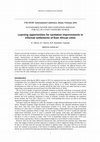
Progress towards full sanitation coverage in urban areas is slow, with one of the big challenges ... more Progress towards full sanitation coverage in urban areas is slow, with one of the big challenges in East Africa and many other areas being reaching the large proportion who live in informal settlements. The unique characteristics of informal settlements impose varying challenges in installing adequate sanitation facilities. A comparative case study using mixed methods conducted in three East African cities revealed varied perceptions of the residents on barriers hindering the process of toilet installation. Lack of money, topography, lack of space, siting on marginal land, difficult to access sanitation material and services and lack of information were perceived as barriers by residents, but differed between cities. There are different examples of successful strategies to tackle the barriers to sanitation in each city and these offer some opportunities for each of the study cities, as well as other cities with similar challenges, to learn how the same challenges are tackled elsewhere.

Environmental Monitoring and Assessment, 2021
Abstract This study investigated the occurrence and seasonal variation in concentrations of emerg... more Abstract This study investigated the occurrence and seasonal variation in concentrations of emerging organic contaminants (EOCs) in shallow groundwater underlying two peri-urban areas of Bwaise (highly urbanised) and Wobulenzi (moderately urbanised) in Uganda. Twenty-six antibiotics, 20 hydrocarbons, including 16 polycyclic aromatic hydrocarbons (PAHs), and 59 pesticides were investigated. Ampicillin and benzylpenicillin were the most frequently detected antibiotics in both areas, although at low concentrations to cause direct harm to human health, but could lead to a proliferation of antibiotic resistance genes. The most frequently detected hydrocarbons in Bwaise were naphthalene and xylene while anthracene and fluoranthene were the most frequent in Wobulenzi, also at low concentrations for ecological impact at long-term exposure. Molecular diagnostic ratios indicated pyrogenic and pyrolytic sources of PAHs in both areas. Cypermethrin (for vermin control) was the most frequent pesticide in Bwaise while metalaxyl (attributed to agriculture) was the most frequent in Wobulenzi. Banned organochlorines (8) were also detected in both areas in low concentrations. The pesticide concentrations between the two areas significantly differed (Z = − 3.558; p < 0.01), attributed to contrasting land-use characteristics. In Wobulenzi (wet season), the total pesticide concentrations at all the locations exceeded the European Community parametric guideline value while 75% of the detected compounds exceeded the individual pesticide guideline value. Thus, the antibiotic and pesticide residues in shallow groundwater underlying both Bwaise and Wobulenzi pose potential adverse ecological effects at long-term exposure. Monitoring of EOCs in both highly and moderately urbanised catchments should be strengthened towards mitigating associated risks. Graphical abstract

Agricultural wastes; Albizia coriaria, Coffea canephora, Cyperus papyrus, Erythrina abyssinica an... more Agricultural wastes; Albizia coriaria, Coffea canephora, Cyperus papyrus, Erythrina abyssinica and Musa spp were evaluated for uptake of aqueous Cd2+ and Pb2+ ions in single- and binary-component solutions. Untreated, base-treated and peroxide-treated biomasses were employed in batch studies. The optimal conditions for Cd2+ and Pb2+ ions biosorption were pH 3.5 – 5 for contact time 3.0 – 3.5 hours and biosorbent dosage 10 – 12.5 g/L. Base-treated biosorbents showed a 10 – 17 % sorption enhancement for Cd2+ ions and a 1.6 – 2.3 % uptake reduction for Pb2+ ions. The sorption capacities for Cd2+ and Pb2+ ions for base-treated biosorbents were between 1.738 and 1.760 mg g-1 compared to 1.415 – 1.539 mg g-1 for untreated materials. The maximum biosorption of peroxide treated materials in single component media was between 0.819 and 1.595 mg/g for Pb2+ ions and between 0.044 and 1.343 mg/g for Cd2+ ions while in binary component media it was between 0.472 and 1.303 mg/g for Pb2+ ions and ...

A study to determine the drinking water quality improvement practises at household level was unde... more A study to determine the drinking water quality improvement practises at household level was undertaken in Kifumbira Zone, a Kampala peri-urban area, Uganda. The socio-economic conditions of 150 households were identified using questionnaires and in-depth interviews. Solar water disinfection (SODIS) was introduced to 10 households and water from their boiled drinking water and SODIS treated water was monitored for three months. The social survey indicated that boiling was the most common method applied to improve the drinking water quality – mainly using charcoal and electricity. 65% of the respondent households boiled their drinking water, while the rest consumed it unboiled due to the high cost of charcoal. The raw water sources exhibited microbiological contamination as evidenced by the presence of thermotolerant coliforms and high risk scores on the sanitary inspections conducted. There was a statistically significant difference (p<0.05; n=15) in the mean count of thermotoler...
The barks of Albizia coriaria, Erythrina abyssinica and peels of Musa spp. were studied in batch ... more The barks of Albizia coriaria, Erythrina abyssinica and peels of Musa spp. were studied in batch for removal of aqueous Cd2+ and Pb2+ ions at pH 4.5, agitation time 3.0 hours for 10 g/L biomass dos ...
Modelling of flow and phosphorus transport in variably saturated soil in a peri-urban settlement ... more Modelling of flow and phosphorus transport in variably saturated soil in a peri-urban settlement in Kampala, Uganda
Using field measurements and solute transport modelling to assess potential for natural remediati... more Using field measurements and solute transport modelling to assess potential for natural remediation of phosphorus in variably staturated soil in a peri-urban settlement in Kampala, Uganda
The limited financial and technological resources available to clean polluted aquifers particular... more The limited financial and technological resources available to clean polluted aquifers particularly in the developing countries such as in Sub-Saharan Africa where degradation of groundwater is rec ...
Single and binary biosorption kinetics for Cd and Pb from aqueous media using Coffea canephora, C... more Single and binary biosorption kinetics for Cd and Pb from aqueous media using Coffea canephora, Cyperus papyrus and Musa spp

Water Science and Technology, 2006
An investigation to assess the anthropogenic pollutant loads, transport and impact on shallow gro... more An investigation to assess the anthropogenic pollutant loads, transport and impact on shallow groundwater in one of Kampala’s peri-urban areas (Bwaise III Parish) was undertaken. Bwaise III is a densely populated informal settlement with a high water table ( 0.25mm/min) result in rapid flooding occurring within 1hr to 2 days. With lower rains, the water table does not rise to the surface, and no flooding takes place. Protection of the shallow groundwater in the area requires socio-technical measures targeting reduction of pollutant loads within the area as well as a wider spring catchment. Re-protection of the spring, coupled with awareness creation, should be immediately addressed so as to reduce microbial contamination. Community participation in solidwaste management should be encouraged. Resource recovery systems such as composting of the mostly organic waste and use of ecological sanitation toilet systems should be piloted in the area. Successful operation of the systems howeve...
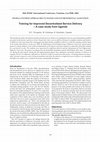
The introduction of decentralization and decentralized service delivery in Uganda placed an incre... more The introduction of decentralization and decentralized service delivery in Uganda placed an increased demand for qualified personnel at the districts and lower levels. Despite this, there were no efforts in the past to enlighten students and trainers at Makerere University about the existing gaps and opportunities available in districts so that the training could be tuned to the needs of the districts. In the year 2000, the Department of Civil Engineering in Makerere University started a pilot project to attach students to the technical departments of the district local governments to undertake internship training for a period of 8 weeks. The students were supervised by staff from districts and the Department of Civil Engineering, Makerere University. The project was financed by the Rockefeller foundation and the World Bank. Since then, 72 students (11 during the pilot and 61 during the full implementation phase) have undergone internship training in 9 districts in Uganda. Eleven (1...

ACS ES&T Water, 2021
We mapped the double-stranded DNA (dsDNA) virus assemblage in groundwater below sub-Saharan urban... more We mapped the double-stranded DNA (dsDNA) virus assemblage in groundwater below sub-Saharan urban poor settlements in Arusha (Tanzania), Dodowa (Ghana), and Kampala (Uganda). Our results indicated that ∼80% of dsDNA virus sequences matched the order of Caudovirales, i.e., indigenous bacteriophages; 1.8% of the dsDNA virus sequences matched those of viral pathogens that infect humans and larger animals, which we defined as so-called above-ground hosts. Within this group, the relative abundances of the genera Chordopoxvirinae, Alphaherpesvirinae, and Betairidovirinae were the highest. Culturable Escherichia coli bacteria were found even in deeper wells, indicating that all water was fecally contaminated. The community assemblages sampled in the cities were statistically significantly different from each other. Dissolved ions, population density, and sanitary status had no significant influence, but pH and latitude did. We concluded that the transport of dsDNA virus in groundwater was location specific but was not determined by input concentrations (i.e., related to population density) or related to groundwater chemistry. We hypothesize that other parameters, like the presence of macropores, cause these variations in these shallow, highly populated, heavily polluted terrestrial groundwater systems. Approximately 34% of Africa has similar hydrogeology, so this may affect many urban areas across the continent.
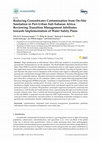
Sustainability, 2020
High urbanization in Sub-Saharan Africa (SSA) has resulted in increased peri-urban groundwater co... more High urbanization in Sub-Saharan Africa (SSA) has resulted in increased peri-urban groundwater contamination by on-site sanitation. The World Health Organization introduced Water Safety Plans (WSP) towards the elimination of contamination risks to water supply systems; however, their application to peri-urban groundwater sources has been limited. Focusing on Uganda, Ghana, and Tanzania, this paper reviews limitations of the existing water regime in addressing peri-urban groundwater contamination through WSPs and normative attributes of Transition Management (TM) towards a sustainable solution. Microbial and nutrient contamination remain prevalent hazards in peri-urban SSA, arising from on-site sanitation within a water regime following Integrated Water Resources Management (IWRM) principles. Limitations to implementation of WSPs for peri-urban groundwater protection include policy diversity, with low focus on groundwater; institutional incoherence; highly techno-centric management t...
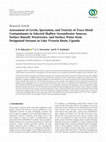
Journal of Environmental and Public Health, 2019
The levels, speciation of elements, and toxicity of selected trace metals as well as other parame... more The levels, speciation of elements, and toxicity of selected trace metals as well as other parameters in selected surface water, shallow groundwater sources, landfill leachate, and associated surface runoff in the Lake Victoria basin, Uganda, were studied. The WHO guidelines, Ugandan standards, Canadian guidelines and Swedish EPA were used for assessment. The shallow groundwater was acidic with pH values below 6.5. The pH, dissolved organic carbon, flouride, and sulphate levels for all springs were below the guideline values although 52.8% was contaminated with nitrates while 39% was contaminated with chloride ions. Some surface water samples had levels of major elements, such as iron, chromium, aluminium, and manganese, above the guideline values. Speciation studies showed that 74% of the metal ions was bound to dissolved organic matter in surface water, whereas in landfill leachates, the dominant ionic species was metal hydroxides or fulvic acid bound. Risk analysis based on the S...
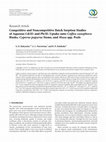
Journal of Chemistry, 2015
Coffea canephora,Cyperus papyrus,andMusaspp. were studied for competitive and noncompetitive remo... more Coffea canephora,Cyperus papyrus,andMusaspp. were studied for competitive and noncompetitive removal of aqueous Cd2+and Pb2+. The optimal conditions were pH 4.5 and agitation time 3.0 hours. Biomass constituent ions showed no interference effects whereas cation exchange capacity values corresponded to the sorption efficiencies. XRD spectroscopy revealed surface oxygen and nitrogen groups that provide binding sites for metal ions. The maximum sorption efficiency ranges for metal ions in noncompetitive media were 95.2–98.7% forC. canephora, 42.0–91.3% forC. papyrus,and 79.9–92.2% forMusaspp. and in competitive sorption 90.8–98.0% forC. canephora, 19.5–90.4% forC. papyrus,and 56.4–89.3% forMusaspp. The Pb2+ions uptake was superior to that of Cd2+ions in competitive and noncompetitive media. In competitive sorption synergistic effects were higher for Cd2+than Pb2+ions. The pseudo-second-order kinetic model fitted experimental data with0.917≤R2≥1.000for Pb2+ions and0.711≤R2≥0.999for Cd2+...
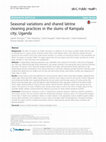
BMC Public Health, 2016
Background: The effect of seasons on health outcomes is a reflection on the status of public heal... more Background: The effect of seasons on health outcomes is a reflection on the status of public health and the state of development in a given society. Evidence shows that in Sub-Saharan Africa, most infectious diseases flourish during the wet months of the year; while human activities in a context of constrained choices in life exacerbate the effects of seasons on human health. The paper argues that, the wet season and when human activities are at their peak, sanitation is most dire poor slum populations. Methods: A shared latrine cleaning observation was undertaken over a period of 6 months in the slums of Kampala city. Data was collected through facility observations, user group meetings, Focus group discussions and, key informant interviews. The photos of the observed sanitation facilities were taken and assessed for facility cleanliness or dirt. Shared latrine pictures, observations, Focus Group Discussion, community meetings and key informant interviews were analysed and subjected to an analysis over the wet, dry and human activity cycles before a facility was categorised as either 'dirty' or 'clean'. Results: Human activity cycles also referred to as socioeconomic seasons were, school days, holidays, weekends and market days. These have been called 'impure' seasons, while the 'pure' seasons were the wet and dry months: improved and unimproved facilities were negatively affected by the wet seasons and the peak seasons of human activity. Wet seasons were associated with, mud and stagnant water, flooding pits and a repugnant smell from the latrine cubicle which made cleaning difficult. During the dry season, latrines became relatively cleaner than during the wet season. The presence of many child(ren) users during school days as well as the influx of market goers for the roadside weekly markets compromised the cleaning outcomes for these shared sanitation facilities. Conclusion: Shared latrine cleaning in slums is impacted by seasonal variations related to weather conditions and human activity. The wet seasons made the already bad sanitation situation worse. The seasonal fluctuations in the state of shared slum sanitation relate to a wider malaise in the population and an implied capacity deficit among urban authorities. Poor sanitation in slums is part of a broader urban mismanagement conundrum pointing towards the urgent need for multiple interventions aimed at improving the general urban living conditions well beyond sanitation.









Uploads
Papers by Robinah Kulabako